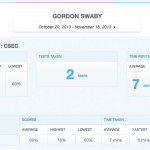When I was brainstorming in the early days I was thinking of ways to “involve” teachers in EduFocal as much as students would be involved. This “involvement” would begin with teachers submitting questions to us. The premise would be that teachers submit questions and get paid based on these submissions. But with that idea came a few problems:
- How would a teacher get paid? Would they get a fixed salary? If so, what if we don’t have enough members on EduFocal to pay salary and other expenses?
- How can you have 50+ teachers for one subject, charge $2000 per year and still manage to remain profitable if paying each a fixed salary?
So, in its most simple form, that system would not work. Enter “performance pay” or as I call it, “commission”. Teachers get from EduFocal as much as they put in, or as the old adage goes they “reap what they sow”.
We came up with three key metrics to measure how much a teacher is paid monthly:
- How often they submit questions to EduFocal
- How well students are doing on the tests set by said teacher
- How they’re [teachers] rated by students at the end of every test.
1. How often they submit questions to EduFocal
Not getting into the dynamics of it ( for obvious reasons), but the more questions a teacher submits to EduFocal the more they’re paid at the end of the month. Each teacher has their own style of writing questions ( both multiple choice and short answer). Teachers also have the ability to leave hints for any question they like. These are the things that will influence how a student rates a teacher at the end of a test. Naturally, some students have their own biases so even if a teacher creates excellent questions they may give the teacher a low rating ( more on this in number #3).
2. How well students are doing on tests
This is kind of self explanatory. The better students are doing on the tests you create, the higher your payout at the end of the month. This is measured in aggregate.
3. Star Ratings
At the end of every test a student has the ability to rate a teacher. 1 star being the lowest rating and 5 star being the highest. Like #2 this is measured in aggregate . As I mentioned in #1 some students, because of their own biases, may not rate a teacher at all or they may give the teacher a low rating. Conversely, teachers may get very high ratings from students who like them. Because of the potential issues that may come with this metric, it has the lowest weighting. i.e. it doesn’t significantly affect a teacher’s payout.
In a sense, EduFocal is the great equalizer for all teachers. Whether young, old, experienced or rookie, you get out what you put in. So you may find that one month you earn as much as $100,000 JMD while only earning $8,000 JMD the next month.
Teachers are listed by popularity on the subject page. The less teachers in a particular subject area the better it is for that particular teacher ( students have less to choose from). Basically, the larger EduFocal gets the better it is for teachers. So it’s in everyone’s best interest to get as many students on EduFocal as possible. Imagine when we expand into other Caribbean countries.
I said in my first paragraph that the teacher’s involvement begins with just question submission, but, there is more to come. This is just the beginning…
We’re always developing so expect some exciting things in the near future.









Introducing the EduFocal Report Card
First!!!!!!!!!!!!!! ...
EduFocal + The Jamaica Observer: The Details!
I am very interested in your program for my son bu ...
EduFocal + The Jamaica Observer: The Details!
wish i could understand more about this website ...
EduFocal + The Jamaica Observer: The Details!
because i am in grade six it can help me with my g ...